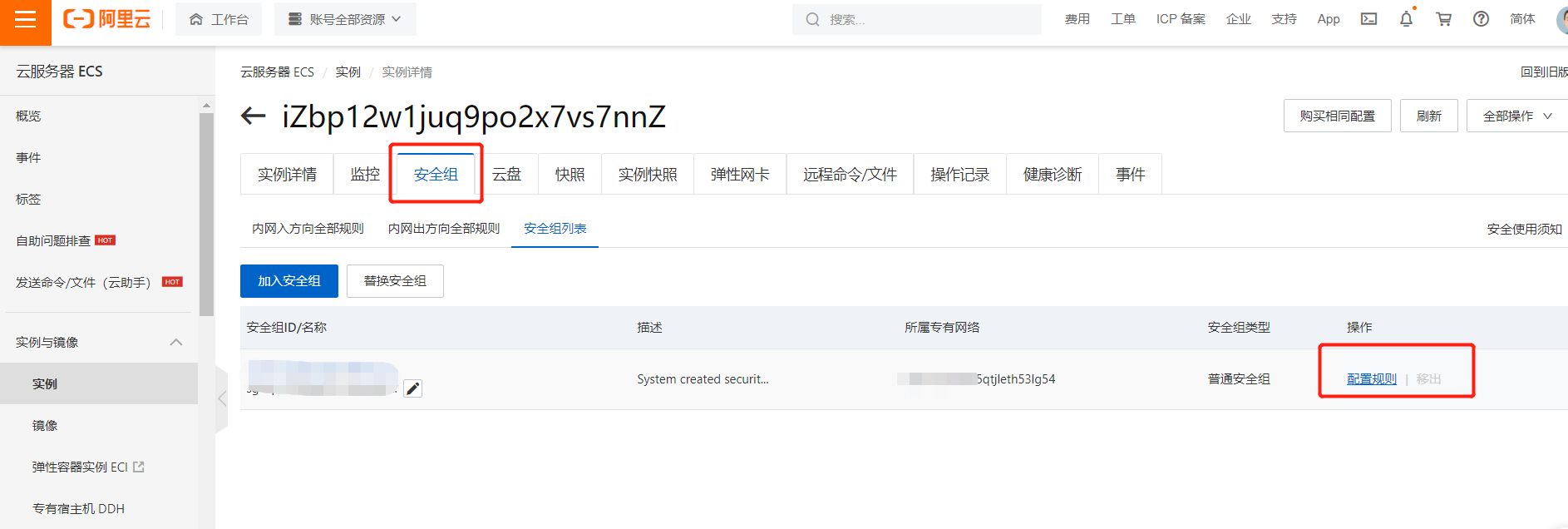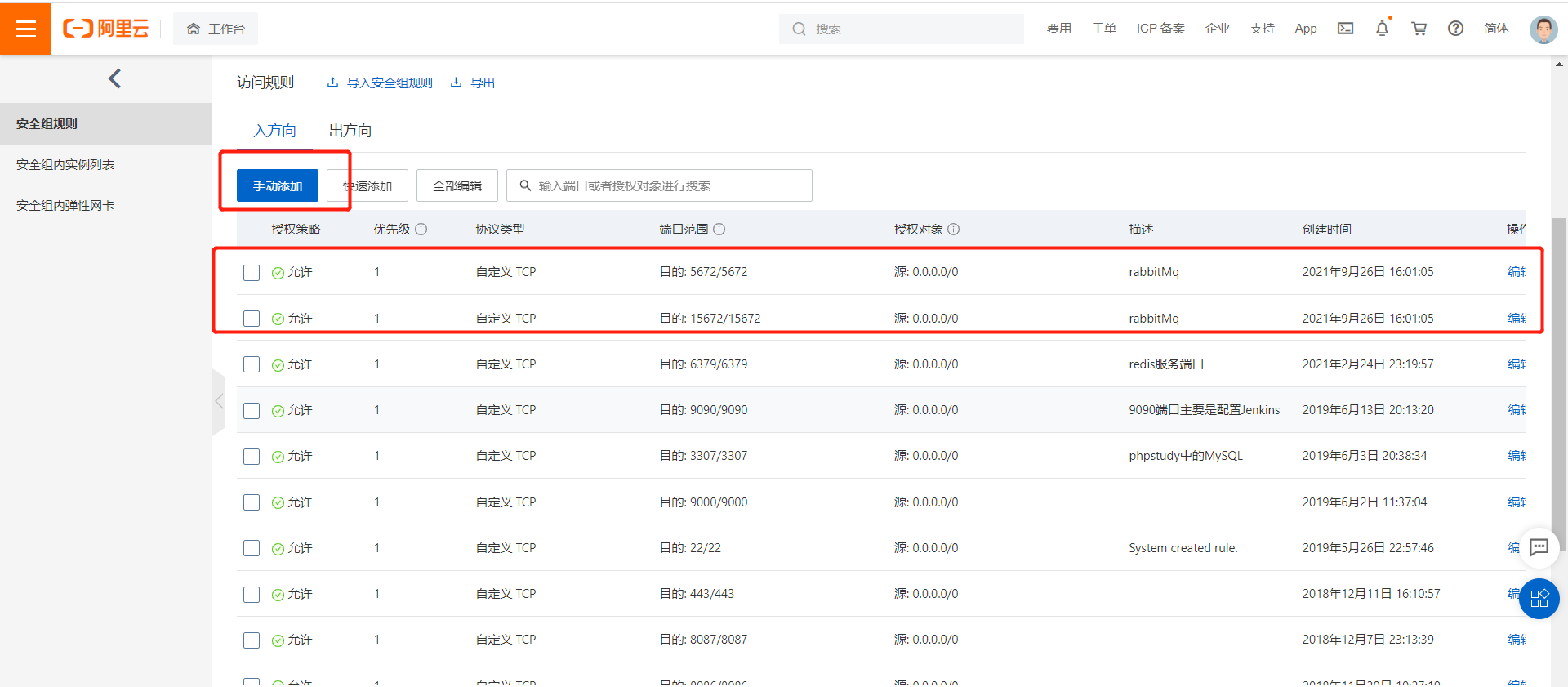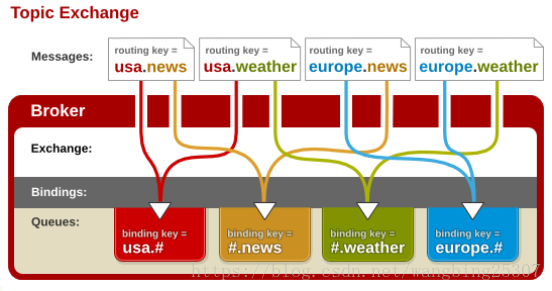Introducción detallada y uso de varios modos comunes de RabbitMQ - práctica
Sitio web oficial: RabbitMQ
Documentación oficial: Introducción a cada modo
RabbitMQ no se presentará en detalle. Los siguientes son los principios y operaciones prácticas de cada modo:
1. Configuración de la instalación
查看mq镜像: docker search rabbitmq:management
下载mq镜像: docker pull rabbitmq:management
安装镜像:docker run -d --name rabbit -e RABBITMQ_DEFAULT_USER=admin -e RABBITMQ_DEFAULT_PASS=admin -p 15672:15672 -p 5672:5672 -p 25672:25672 -p 61613:61613 -p 1883:1883 rabbitmq:management
说明
5672:默认的客户端连接的端口
15672:默认的web管理界面的端口
命令中的【RABBITMQ_DEFAULT_USER=admin -e RABBITMQ_DEFAULT_PASS=admin】是web管理平台的用户名和密码
【 -p 15672:15672】 是控制平台docker映射到系统的对应端口
【 -p 5672:5672】 是应用程序的访问端口
访问地址
http://ip:15672
Si es un servidor Linux, primero abra el puerto del servidor, como Alibaba Cloud, primero configure el grupo de seguridad:

Añadir:

iniciar la instalación:
Preguntardocker search rabbitmq:management

descargardocker search rabbitmq:management
Instalardocker run -d --name rabbit -e RABBITMQ_DEFAULT_USER=admin -e RABBITMQ_DEFAULT_PASS=admin -p 15672:15672 -p 5672:5672 -p 25672:25672 -p 61613:61613 -p 1883:1883 rabbitmq:management

Instalación exitosa

Dirección de acceso:
http://tu ip:15672
2. prueba
Primero crea una clase de conexión:
package boot.spring.controller;
import com.rabbitmq.client.Connection;
import com.rabbitmq.client.ConnectionFactory;
/**
* @description
* @AUTHER: sk
* @DATE: 2021/9/26
**/
public class ConnectionUtil {
/**
* 获取连接
* @return Connection
* @throws Exception
*/
public static Connection getConnection() throws Exception {
//定义连接工厂
ConnectionFactory factory = new ConnectionFactory();
factory.setHost("你的ip");
factory.setPort(5672);
//设置vhost
factory.setVirtualHost("/");
factory.setUsername("admin");
factory.setPassword("admin");
//通过工厂获取连接
Connection connection = factory.newConnection();
return connection;
}
}
2.1 Modo sencillo
Un productor, un consumidor.
Esquemático:
enviar:
package boot.spring.controller.easy;
import boot.spring.controller.ConnectionUtil;
import com.rabbitmq.client.Channel;
import com.rabbitmq.client.Connection;
/**
* @description 1.简单模式:一个生产者一个消费者
* @AUTHER: sk
* @DATE: 2021/9/26
**/
public class TestSend {
public final static String QUEUE_NAME = "test-queue";
//创建队列,发送消息
public static void main(String[] args) throws Exception {
//获取连接
Connection connection = ConnectionUtil.getConnection();
//创建通道
Channel channel = connection.createChannel();
//声明创建队列
channel.queueDeclare(QUEUE_NAME,false,false,false,null);
//消息内容
String message = "Hello World!";
channel.basicPublish("",QUEUE_NAME,null,message.getBytes());
System.out.println("发送消息:"+message);
//关闭连接和通道
channel.close();
connection.close();
}
}

Un mensaje producido no se consume:

tomar el control:
package boot.spring.controller.easy;
import boot.spring.controller.ConnectionUtil;
import com.rabbitmq.client.Channel;
import com.rabbitmq.client.Connection;
import com.rabbitmq.client.QueueingConsumer;
/**
* @description 简单模式一个生产者一个消费者
* @AUTHER: sk
* @DATE: 2021/9/26
**/
public class TestResive {
//消费者消费消息
public static void main(String[] args) throws Exception {
//获取连接和通道
Connection connection = ConnectionUtil.getConnection();
Channel channel = connection.createChannel();
//声明通道
channel.queueDeclare(TestSend.QUEUE_NAME,false,false,false,null);
//定义消费者
QueueingConsumer consumer = new QueueingConsumer(channel);
//监听队列
channel.basicConsume(TestSend.QUEUE_NAME,true,consumer);
while(true){
//这个方法会阻塞住,直到获取到消息
QueueingConsumer.Delivery delivery = consumer.nextDelivery();
String message = new String(delivery.getBody());
System.out.println("接收到消息:"+message);
}
}
}

ha sido consumido por:

2.2 modo de trabajo
modelo de consumo competitivo
Un productor, varios consumidores, cada consumidor recibe un mensaje único y el mensaje producido se dividirá entre los consumidores.
Esquemático:
Para producir 100 mensajes:
package boot.spring.controller.work;
import boot.spring.controller.ConnectionUtil;
import com.rabbitmq.client.Channel;
import com.rabbitmq.client.Connection;
/**
* @description 2.work模式:一个生产者多个消费者
* @AUTHER: sk
* @DATE: 2021/9/26
**/
public class WorkSend2 {
public final static String QUEUE_NAME = "test2";
//消息生产者
public static void main(String[] args) throws Exception {
//获取连接和通道
Connection connection = ConnectionUtil.getConnection();
Channel channel = connection.createChannel();
//声明队列
channel.queueDeclare(QUEUE_NAME,false,false,false,null);
String message = "";
for(int i = 0; i<100; i++){
message = "" + i;
channel.basicPublish("",QUEUE_NAME,null,message.getBytes());
System.out.println("发送消息:"+message);
Thread.sleep(i);
}
channel.close();
connection.close();
}
}

Consumidor 1:
package boot.spring.controller.work;
import boot.spring.controller.ConnectionUtil;
import com.rabbitmq.client.Channel;
import com.rabbitmq.client.Connection;
import com.rabbitmq.client.QueueingConsumer;
/**
* @description 2.work模式:一个生产者多个消费者
* @AUTHER: sk
* @DATE: 2021/9/26
**/
public class WorkResive1 {
//消费者1 自动模式
public static void main(String[] args) throws Exception {
Connection connection = ConnectionUtil.getConnection();
Channel channel = connection.createChannel();
channel.queueDeclare(WorkSend2.QUEUE_NAME,false,false,false,null);
//同一时刻服务器只发送一条消息给消费端
channel.basicQos(1);
QueueingConsumer consumer = new QueueingConsumer(channel);
channel.basicConsume(WorkSend2.QUEUE_NAME,false,consumer);
while(true){
QueueingConsumer.Delivery delivery = consumer.nextDelivery();
String message = new String(delivery.getBody());
System.out.println("recive1:"+message);
Thread.sleep(100);
//消息消费完给服务器返回确认状态,表示该消息已被消费
channel.basicAck(delivery.getEnvelope().getDeliveryTag(),false);
}
}
}
Consumidor 1, consumiendo la mitad de los 100 mensajes:

Consumidor 2:
package boot.spring.controller.work;
import boot.spring.controller.ConnectionUtil;
import com.rabbitmq.client.Channel;
import com.rabbitmq.client.Connection;
import com.rabbitmq.client.QueueingConsumer;
/**
* @description 2.work模式:一个生产者多个消费者
* @AUTHER: sk
* @DATE: 2021/9/26
**/
public class WorkResive2 {
//消费者2 手动模式
public static void main(String[] args) throws Exception {
Connection connection = ConnectionUtil.getConnection();
Channel channel = connection.createChannel();
channel.queueDeclare("test2",false,false,false,null);
channel.basicQos(1);
QueueingConsumer consumer = new QueueingConsumer(channel);
channel.basicConsume("test2",true,consumer);
while(true){
QueueingConsumer.Delivery delivery = consumer.nextDelivery();
String message = new String(delivery.getBody());
System.out.println("recive1:"+message);
Thread.sleep(10);
//channel.basicAck(delivery.getEnvelope().getDeliveryTag(),false);
}
}
}
El consumidor 2 consume la otra mitad de los 100 mensajes:

2.3 Modo de Suscripción
Los productores envían mensajes a los intercambios y los consumidores reciben mensajes de los intercambios.
Esquemático:
El productor envía un mensaje al intercambio:
package boot.spring.controller.exchange;
import boot.spring.controller.ConnectionUtil;
import com.rabbitmq.client.Channel;
import com.rabbitmq.client.Connection;
/**
* @description 3.订阅者模式:一个生产者发送的消息会被多个消费者获取
* @AUTHER: sk
* @DATE: 2021/9/26
**/
public class Send {
public static final String EXCHANGE_NAME = "test_exchange_fanout";
//生产者,发送消息到交换机
public static void main(String[] args) throws Exception {
Connection connection = ConnectionUtil.getConnection();
Channel channel = connection.createChannel();
//声明交换机 fanout:交换机类型 主要有fanout,direct,topics三种
channel.exchangeDeclare(EXCHANGE_NAME,"fanout");
String message = "订阅模式:消息007!";
channel.basicPublish(EXCHANGE_NAME,"",null,message.getBytes());
System.out.println(message);
channel.close();
connection.close();
}
}
Mensajes producidos:

Consumidor 1:
package boot.spring.controller.exchange;
import boot.spring.controller.ConnectionUtil;
import com.rabbitmq.client.Channel;
import com.rabbitmq.client.Connection;
import com.rabbitmq.client.QueueingConsumer;
/**
* @description 3.订阅者模式:一个生产者发送的消息会被多个消费者获取
* @AUTHER: sk
* @DATE: 2021/9/26
**/
public class Resive1 {
//消费者1
public final static String QUEUE_NAME = "test_queue_exchange_1";
public static void main(String[] args) throws Exception {
Connection connection = ConnectionUtil.getConnection();
Channel channel = connection.createChannel();
channel.queueDeclare(QUEUE_NAME,false,false,false,null);
//绑定队列到交换机上
channel.queueBind(QUEUE_NAME,Send.EXCHANGE_NAME,"");
channel.basicQos(1);
QueueingConsumer consumer = new QueueingConsumer(channel);
channel.basicConsume(QUEUE_NAME,true,consumer);
while(true){
QueueingConsumer.Delivery delivery = consumer.nextDelivery();
String message = new String(delivery.getBody());
System.out.println("消费者1:"+message);
}
}
}

Consumidor 2:
package boot.spring.controller.exchange;
import boot.spring.controller.ConnectionUtil;
import com.rabbitmq.client.Channel;
import com.rabbitmq.client.Connection;
import com.rabbitmq.client.QueueingConsumer;
/**
* @description 3.订阅者模式:一个生产者发送的消息会被多个消费者获取
* @AUTHER: sk
* @DATE: 2021/9/26
**/
public class Resive2 {
//消费者2
public final static String QUEUE_NAME = "test_queue_exchange_2";
public static void main(String[] args) throws Exception {
Connection connection = ConnectionUtil.getConnection();
Channel channel = connection.createChannel();
channel.queueDeclare(QUEUE_NAME,false,false,false,null);
//绑定队列到交换机上
channel.queueBind(QUEUE_NAME,Send.EXCHANGE_NAME,"");
channel.basicQos(1);
QueueingConsumer consumer = new QueueingConsumer(channel);
channel.basicConsume(QUEUE_NAME,true,consumer);
while(true){
QueueingConsumer.Delivery delivery = consumer.nextDelivery();
String message = new String(delivery.getBody());
System.out.println("消费者2:"+message);
}
}
}

Se puede ver que en el modo de abonado, todos los consumidores han recibido mensajes a través del conmutador.
2.4 Modo de enrutamiento
Cuando el productor envía un mensaje a la cola, puede personalizar una clave y el consumidor puede seleccionar el mensaje correspondiente de acuerdo con la clave y obtener lo que necesita.
Nota: La clave de enrutamiento es una coincidencia exacta y solo los consumidores coincidentes pueden consumir mensajes.
Esquemático:
El productor produce mensajes con clave: (clave="perro")
package boot.spring.controller.rout;
import boot.spring.controller.ConnectionUtil;
import com.rabbitmq.client.Channel;
import com.rabbitmq.client.Connection;
/**
* @description 4.路由模式:发送消息到交换机并且要指定路由key
* @AUTHER: sk
* @DATE: 2021/9/26
**/
public class RoutSend {
public static final String EXCHANGE_NAME = "test_exchange_direct";
//生产者
public static void main(String[] args) throws Exception {
Connection connection = ConnectionUtil.getConnection();
Channel channel = connection.createChannel();
//声明交换机 fanout:交换机类型 主要有fanout,direct,topics三种
channel.exchangeDeclare(EXCHANGE_NAME,"direct");
String message = "路由模式产生的消息!";
channel.basicPublish(EXCHANGE_NAME,"dog",null,message.getBytes());
System.out.println(message);
channel.close();
connection.close();
}
}

Consumidor 1: (clave="perro")
package boot.spring.controller.rout;
import boot.spring.controller.ConnectionUtil;
import com.rabbitmq.client.Channel;
import com.rabbitmq.client.Connection;
import com.rabbitmq.client.QueueingConsumer;
/**
* @description 4.路由模式:消费者将队列绑定到交换机时需要指定路由key
* @AUTHER: sk
* @DATE: 2021/9/26
**/
public class RoutResive1 {
//消费者1
public final static String QUEUE_NAME = "test_queue_direct_1";
public static void main(String[] args) throws Exception {
Connection connection = ConnectionUtil.getConnection();
Channel channel = connection.createChannel();
channel.queueDeclare(QUEUE_NAME,false,false,false,null);
//绑定队列到交换机上,并制定路由键为"dog"
channel.queueBind(QUEUE_NAME, RoutSend.EXCHANGE_NAME,"dog");
channel.basicQos(1);
QueueingConsumer consumer = new QueueingConsumer(channel);
channel.basicConsume(QUEUE_NAME,true,consumer);
while(true){
QueueingConsumer.Delivery delivery = consumer.nextDelivery();
String message = new String(delivery.getBody());
System.out.println("RoutResive1:"+message);
}
}
}

Consumidor 2: (clave="gato")
package boot.spring.controller.rout;
import boot.spring.controller.ConnectionUtil;
import com.rabbitmq.client.Channel;
import com.rabbitmq.client.Connection;
import com.rabbitmq.client.QueueingConsumer;
/**
* @description 4.路由模式:消费者将队列绑定到交换机时需要指定路由key
* @AUTHER: sk
* @DATE: 2021/9/26
**/
public class RoutResive2 {
//消费者2
public final static String QUEUE_NAME = "test_queue_direct_2";
public static void main(String[] args) throws Exception {
Connection connection = ConnectionUtil.getConnection();
Channel channel = connection.createChannel();
channel.queueDeclare(QUEUE_NAME,false,false,false,null);
//绑定队列到交换机上,并制定路由键为"cat"
channel.queueBind(QUEUE_NAME, RoutSend.EXCHANGE_NAME,"cat");
channel.basicQos(1);
QueueingConsumer consumer = new QueueingConsumer(channel);
channel.basicConsume(QUEUE_NAME,true,consumer);
while(true){
QueueingConsumer.Delivery delivery = consumer.nextDelivery();
String message = new String(delivery.getBody());
System.out.println("RoutResive2:"+message);
}
}
}

Obviamente, el consumidor 1 entendió el mensaje, pero el consumidor 2 no entendió el mensaje, porque la clave del consumidor 2 es inconsistente con la clave del productor.
2.5 Patrón comodín
El principio es similar al modo de enrutamiento, excepto que el valor clave tiene una coincidencia aproximada.
-
* (asterisco) puede reemplazar exactamente una palabra.
-
# (hash) puede reemplazar cero o más palabras
-
El intercambio de temas asigna el atributo de la clave de enrutamiento del mensaje a través de la coincidencia de patrones y hace coincidir la clave de enrutamiento con un patrón determinado. En este momento, la cola debe vincularse a un patrón. Divide la cadena de claves de enrutamiento y claves de enlace en palabras separadas por puntos. También reconoce dos caracteres comodín: el símbolo "#" y el símbolo "*". # coincide con 0 o más palabras, * coincide con una palabra. Como se muestra abajo:

Esquemático:
El productor produce el mensaje:
package boot.spring.controller.topic;
import boot.spring.controller.ConnectionUtil;
import com.rabbitmq.client.Channel;
import com.rabbitmq.client.Connection;
/**
* @description 5.路由模式:发送消息到交换机并且要指定通配符路由
* @AUTHER: sk
* @DATE: 2021/9/26
**/
public class TopicSend {
//生产者
public static final String EXCHANGE_NAME = "test_exchange_topic";
public static void main(String[] args) throws Exception {
Connection connection = ConnectionUtil.getConnection();
Channel channel = connection.createChannel();
//声明交换机 topic:交换机类型
channel.exchangeDeclare(EXCHANGE_NAME,"topic");
String message = "通配符模式产生的消息";
channel.basicPublish(EXCHANGE_NAME,"dog.1",null,message.getBytes());
System.out.println(message);
channel.close();
connection.close();
}
}

Consumidor 1:
package boot.spring.controller.topic;
import boot.spring.controller.ConnectionUtil;
import com.rabbitmq.client.Channel;
import com.rabbitmq.client.Connection;
import com.rabbitmq.client.QueueingConsumer;
/**
* @description 5.路由模式:消费者将队列绑定到交换机时需要指定通配符路由key
* @AUTHER: sk
* @DATE: 2021/9/26
**/
public class TopicResive1 {
//消费者1
public final static String QUEUE_NAME = "test_queue_topic_1";
public static void main(String[] args) throws Exception {
Connection connection = ConnectionUtil.getConnection();
Channel channel = connection.createChannel();
channel.queueDeclare(QUEUE_NAME,false,false,false,null);
//绑定队列到交换机上,并制定路由键匹配规则为"dog.*"
channel.queueBind(QUEUE_NAME, TopicSend.EXCHANGE_NAME,"dog.*");
channel.basicQos(1);
QueueingConsumer consumer = new QueueingConsumer(channel);
channel.basicConsume(QUEUE_NAME,true,consumer);
while(true){
QueueingConsumer.Delivery delivery = consumer.nextDelivery();
String message = new String(delivery.getBody());
System.out.println("TopicResive1:"+message);
}
}
}

Consumidor 2:
package boot.spring.controller.topic;
import boot.spring.controller.ConnectionUtil;
import com.rabbitmq.client.Channel;
import com.rabbitmq.client.Connection;
import com.rabbitmq.client.QueueingConsumer;
/**
* @description 5.路由模式:消费者将队列绑定到交换机时需要指定通配符路由key
* @AUTHER: sk
* @DATE: 2021/9/26
**/
public class TopicResive2 {
//消费者2
public final static String QUEUE_NAME = "test_queue_topic_2";
public static void main(String[] args) throws Exception {
Connection connection = ConnectionUtil.getConnection();
Channel channel = connection.createChannel();
channel.queueDeclare(QUEUE_NAME,false,false,false,null);
//绑定队列到交换机上,并制定路由键匹配规则为"#.1"
channel.queueBind(QUEUE_NAME, TopicSend.EXCHANGE_NAME,"#.1");
channel.basicQos(1);
QueueingConsumer consumer = new QueueingConsumer(channel);
channel.basicConsume(QUEUE_NAME,true,consumer);
while(true){
QueueingConsumer.Delivery delivery = consumer.nextDelivery();
String message = new String(delivery.getBody());
System.out.println("TopicResive2:"+message);
}
}
}

Consumidor 3:
package boot.spring.controller.topic;
import boot.spring.controller.ConnectionUtil;
import com.rabbitmq.client.Channel;
import com.rabbitmq.client.Connection;
import com.rabbitmq.client.QueueingConsumer;
/**
* @description 5.路由模式:消费者将队列绑定到交换机时需要指定通配符路由key
* @AUTHER: sk
* @DATE: 2021/9/26
**/
public class TopicResive3 {
//消费者3
public final static String QUEUE_NAME = "test_queue_topic_3";
public static void main(String[] args) throws Exception {
Connection connection = ConnectionUtil.getConnection();
Channel channel = connection.createChannel();
channel.queueDeclare(QUEUE_NAME,false,false,false,null);
//绑定队列到交换机上,并制定路由键匹配规则为"cat.#"
channel.queueBind(QUEUE_NAME, TopicSend.EXCHANGE_NAME,"cat.#");
channel.basicQos(1);
QueueingConsumer consumer = new QueueingConsumer(channel);
channel.basicConsume(QUEUE_NAME,true,consumer);
while(true){
QueueingConsumer.Delivery delivery = consumer.nextDelivery();
String message = new String(delivery.getBody());
System.out.println("TopicResive3:"+message);
}
}
}

Resultado: el consumidor 1 y el consumidor 2 pueden recibir el mensaje, pero el consumidor 3 no puede recibir el mensaje.
Dirección completa del código:
dirección de Git
https://github.com/DongFangXiaoYu/springBoot-RabbitMq/tree/master